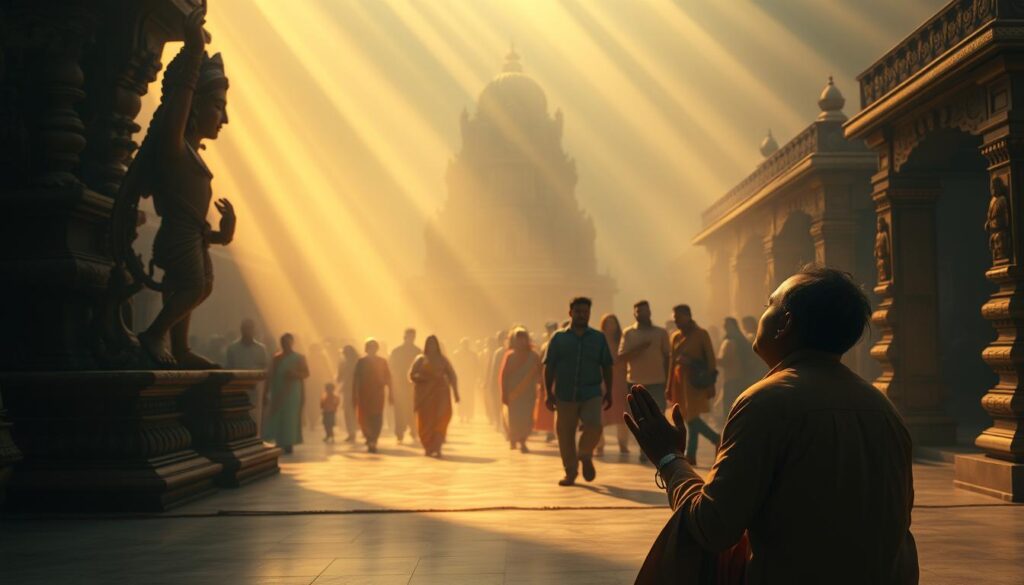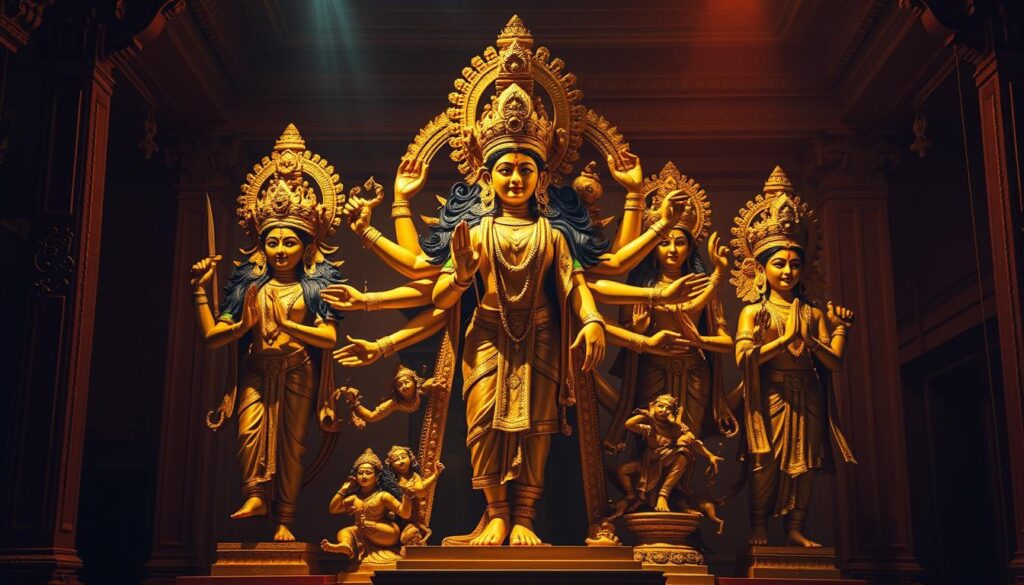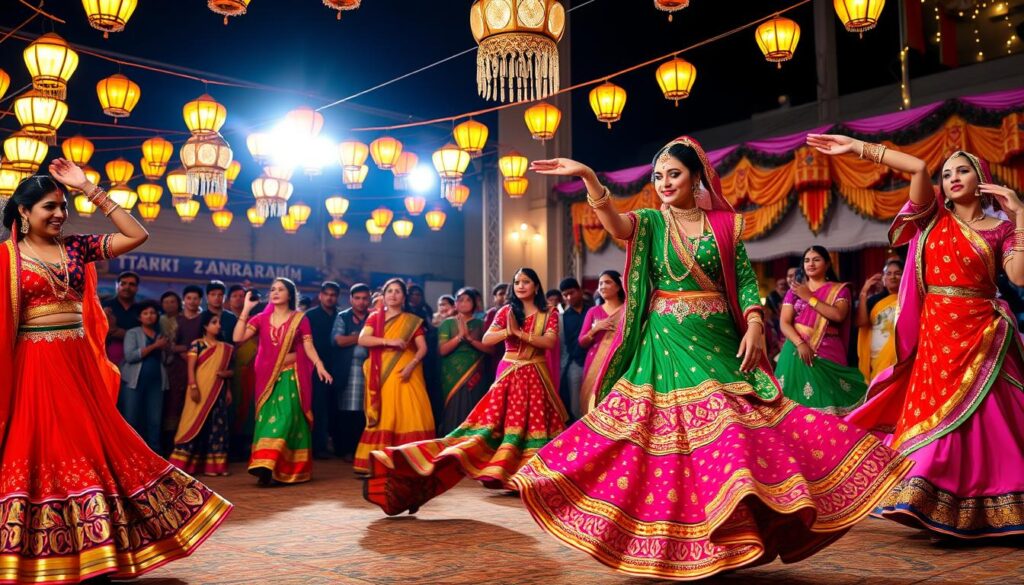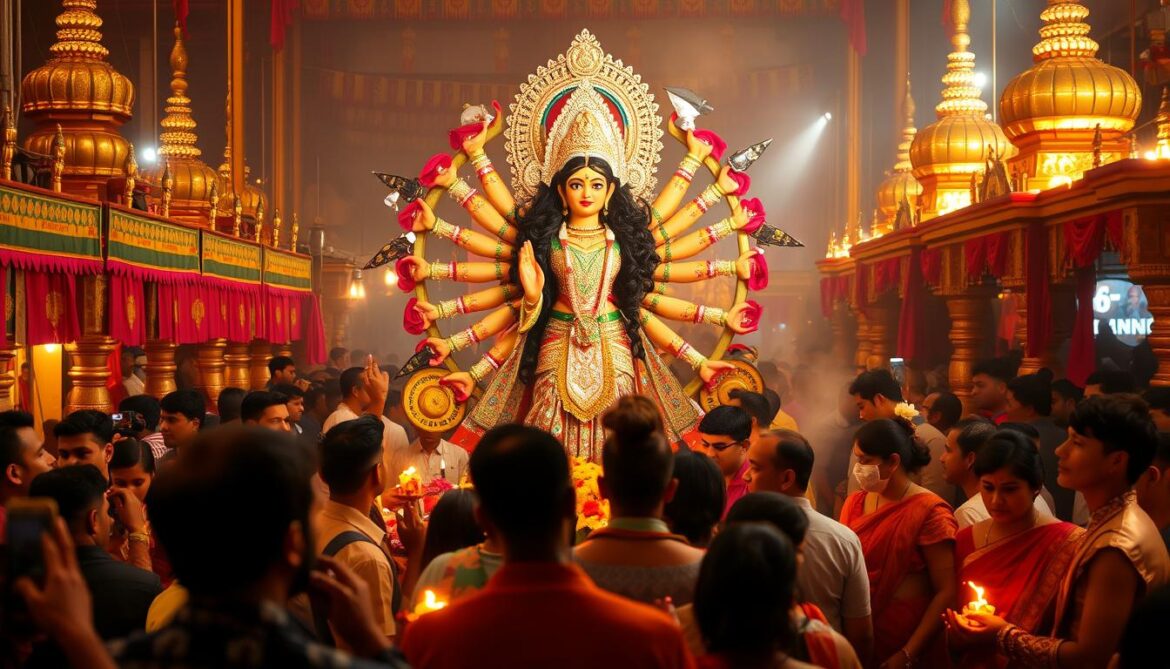Hindu culture celebrates the divine feminine through vibrant traditions. One of the most revered events is the nine-night festival honoring the goddess Durga. This occasion marks a powerful spiritual journey.
The festival symbolizes the victory of light over darkness. Stories tell of Durga’s triumph against evil forces, representing the eternal struggle between good and bad. These tales inspire millions across generations.
Each autumn, communities come alive with color and devotion. The transition from monsoon rains to cooler weather brings renewal. People embrace both ancient rituals and modern expressions of faith.
Beyond religious aspects, this celebration unites families and neighbors. It blends prayer with joyful gatherings, creating lasting memories. The festival’s energy reflects the enduring strength of cultural heritage.
1. The Mythological Roots of Durga and Navratri
Ancient tales speak of a cosmic battle that shaped Hindu traditions. At its heart lies the legend of Mahishasura, a shape-shifting demon who unleashed chaos across the world. The gods, powerless against his tyranny, pooled their energy to create a formidable warrior—the radiant goddess Durga.
The Battle of Durga and Mahishasura
For nine nights, the goddess clashed with the buffalo demon. Each day, Mahishasura transformed—symbolizing life’s fleeting challenges. On the ninth day, Durga pierced his heart, restoring cosmic balance. This victory became the foundation of Navratri.
Vijayadashami: The Triumph of Good Over Evil
The tenth day, Vijayadashami, marks the triumph of light over darkness. Communities reenact this moment through rituals like idol immersion, symbolizing the release of ego. In Bengal, clay statues dissolve into rivers, echoing the demon’s defeat.
Beyond mythology, the festival aligns with autumn’s harvest season. It reminds devotees that inner battles—like crops—require patience and faith to bloom. Regional retellings add vibrant layers, yet the core message endures: good evil struggles shape our collective spirit.
2. The Spiritual Significance of Navratri

Beyond vibrant festivities, the nine nights offer a path to self-discovery. This period encourages devotees to mirror the goddess’s victory by conquering inner shadows. Rituals become stepping stones to clarity.
Navratri as a Journey of Inner Transformation
The festival’s structure reflects life’s cycles. Days 1-3 focus on releasing inertia (tamas), like shedding procrastination. Days 4-6 ignite energy (rajas), channeling ambition productively.
Final days 7-9 cultivate sattva—pure awareness. Chanting mantras acts as a “bath” for the mind, absorbing sacred vibrations. Sadhguru’s advice resonates: “Be non-serious but absolutely involved.”
The Three Gunas: Tamas, Rajas, and Sattva
These three gunas govern human psychology. Tamas binds, rajas drives, and sattva liberates. Recognizing them helps navigate daily struggles. The festival’s phases teach balance.
Navratri Fasting and Its Purifying Role
Fasting isn’t deprivation but detoxification. Light meals or fruits reduce sensory overload. This sharpens focus, making worship more profound. It’s a reset for body and mind.
Evening rituals replace meals with meditation. Families share simple dishes, reinforcing unity. The practice mirrors autumn’s harvest—letting go to reap wisdom.
3. The Nine Forms of Goddess Durga and Their Meanings

From mountains to cosmic wisdom, the divine feminine manifests in varied forms. Each day Navratri unveils a new aspect of the goddess, guiding spiritual seekers through layered symbolism. These nine forms mirror both cosmic creation and personal evolution.
Shailaputri to Siddhidatri: A Daily Devotion
Day one begins with Shailaputri, riding a bull with trident in hand. She represents raw energy, like mountain streams carving valleys. Devotees wear red and offer pure ghee, symbolizing ignited potential.
By the fourth day, Kushmanda emerges as the universe’s womb. Her eight arms hold a rosary and weapons—balance between creation and protection. Yellow flowers adorn altars, reflecting solar vitality.
Symbolism Behind Each Form of Durga
The sixth form Katyayani rides a lion, her sword cutting through fear. “Skandamata is the mother of 64 arts and sciences,” notes Art of Living teachings. She cradles infant Kartikeya, embodying nurturing courage.
Dark-hued Kalaratri on day seven wears a necklace of lightning. Her fierce stance destroys ignorance, much like storms clear deadwood. Devotees meditate before brass idols to absorb this transformative power.
Siddhidatri concludes the cycle seated on a lotus. Her four arms grant blessings of supernatural wisdom. The nine forms together form a roadmap from earthly strength to cosmic consciousness.
4. How Navratri is Celebrated Across India

From Gujarat’s swirling dances to Bengal’s artistic pandals, celebrations vary widely. Each region adds unique colors to this festival, blending devotion with local heritage. The rhythms, rituals, and flavors tell a story of unity in diversity.
Garba and Dandiya: The Heartbeat of Gujarat
Night skies glow with lanterns as circles of dancers move to clapping sticks. Women in mirror-work chaniya cholis twirl, their steps echoing the universe’s cycles. Garba rings symbolize the never-ending dance of creation.
Men join with Dandiya sticks, their strikes representing the clash between divine and mortal. Mumbai’s star-studded events fuse Bollywood glamour with tradition. Overseas, communities adapt with salsa-infused beats.
Durga Puja in West Bengal: A Grand Spectacle
Kolkata becomes an open-air gallery with towering pandals. Artists spend months crafting intricate Durga idols from clay and straw. On Mahanavami, married women smear vermilion during sindoor khela, celebrating feminine power.
Streets buzz with food stalls selling luchi-alur dom. The Durga Puja finale sees emotional idol immersions. Young girls embody the goddess during Kumari Puja, their feet washed with reverence.
Ayudha Pooja and Mahanavami in the South
In Karnataka, tools transform into sacred objects. Cars, computers, and hammers receive floral garlands on Ayudha Pooja. This ritual honors Saraswati, the goddess of wisdom.
Tamil Nadu observes Bommai Kolu, displaying dolls on stepped altars. Families exchange coconut gifts while fasting on sabudana khichdi. The South’s quieter rituals highlight introspection over spectacle.
5. Durga and Navratri’s Relevance in Modern Times
Today’s fast-paced world finds balance through timeless traditions. The festival adapts while preserving its core energy, offering solace in chaotic times. Devotees now blend ancient wisdom with contemporary needs.
Mental wellness trends align with ritual fasting. Detoxifying the body mirrors clearing mental clutter. Many see it as a holistic reset for modern life stresses.
Sustainability shapes celebrations too. Clay idols dissolve harmlessly, and seed-based prasad grows into plants. These eco-friendly aspects honor nature’s cycles.
Virtual celebrations emerged post-pandemic. Live aartis and online Garba classes connect global communities. The goddess’s warrior spirit inspires female empowerment movements across India.
As Sadhguru notes, “This is a time to awaken your highest potential.” The festival remains a beacon of culture and knowledge, evolving yet eternal.

